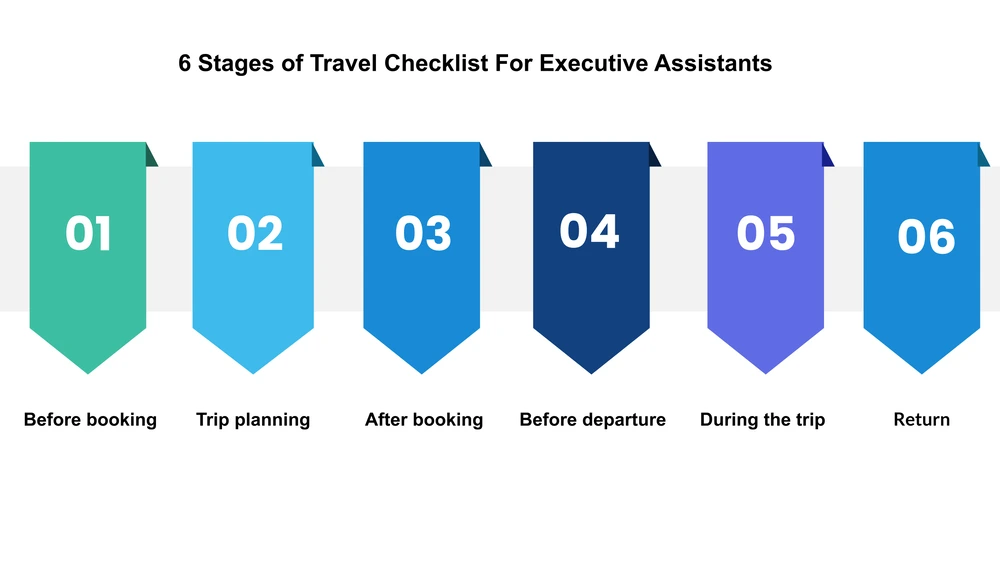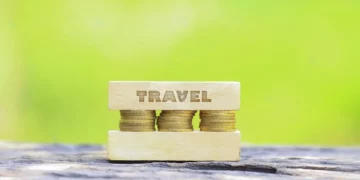Last Updated on November 28, 2025
Executive assistant travel checklist
As an executive assistant, you’ll create Excel spreadsheets one moment and pick up a bouquet of flowers the next. You might leave the office at 5 pm sharp for weeks, then need to pull a random all-nighter—or two.
According to Zippia, there are over 350,000 executive assistants in the United States alone. Being an executive assistant can sometimes be stressful, but it’s unquestionably rewarding.
Part of being an executive assistant is becoming your boss’s personal travel agent, which includes the planning and smooth execution of business trips. Planning a personal vacation is stressful enough—but planning a full-on, professional business trip for your boss?
In this article, we’ll take a look at the essential to-do items for executive assistants, so you can rest assured that your exec will have the most enjoyable business travel experience possible.
Also, Read: What are Business Travel Expenses?
Why is the travel checklist for executive assistants important?
Business travel differs from leisure travel in that there are specific company objectives that need to be accomplished. For example, executives may be trying to secure a deal with a new client or reviewing the finances of a different company branch.
Due to the stress of accomplishing these company goals, most executives demand a certain level of comfort while traveling; they expect the planning and logistical parts of the process to be taken care of for them.
This is the job of the executive assistant.
Given the sheer quantity of preparatory tasks that need to be completed and details that need to be checked and rechecked, a comprehensive checklist should be an essential piece of the executive assistant’s travel planning process.
What should you include in the travel checklist?
A good travel checklist should include all the major, obvious tasks to the smallest, most minute details. It’s especially important to include emergency backup plans in case flights get canceled or meetings get rescheduled.
You should also include any seemingly insignificant considerations that, though potentially unnecessary, may leave your executive impressed by your commitment and attention to detail.
How to create a travel checklist for executive assistants?
Your screen lights up with a message from your boss. He needs to travel for an important meeting with a wealthy client, and the client hasn’t yet specified exactly where – but the meeting is next week!
Where do you begin? First, take some deep breaths.
Start by creating a checklist template in a spreadsheet or text document. Keep it organized, and make sure the layout is intuitive and easy for you to skim through.
As opposed to lumping everything together into one haphazard list, it’s helpful to create a timeline and break your list down into six stages:
- Before booking
- Trip planning
- After booking
- Before departure
- During the trip
- Return

6 stages of travel checklist for executive assistants
1. Travel checklist: Before booking a trip
Now that you know this business trip is in the pipeline, you can immediately gather generic data.
- Passport – For international travel, the passport is an essential document. Confirm that your executive’s passport has not expired and research visa requirements for the destination country. Some visas can be obtained online, while others can be issued upon arrival. If you must obtain the visa online, be sure to begin this process as soon as possible, as there is often a significant amount of paperwork and sometimes delays.
- Personal information – Write down your executive’s travel preferences: mode of transportation, restaurants, dietary restrictions, and mode of communication. Make a note if they are frequent flyers and may be entitled to discounts.
- Corporate policy – Refresh yourself on your company’s corporate travel policies; this includes travel best practices, as well as budgets and permissible spending limits based on employee grade. Doing this groundwork now will ensure that the rest of the trip falls safely within the bounds of the company’s policies. Happay is a travel management software that can largely automate this process, reducing your pre-trip workload. If your company has travel insurance, gather all necessary documentation.
- Emergencies – Create a list of emergency contact information for your executive. Include phone numbers and email addresses.
Quick Read: What is a Corporate Travel Program?
2. Travel checklist: When planning a trip
Finally, your boss messages you again with more information: he’ll be going overseas to London to meet with a supplier.
Now that you know the intended purpose and destination of the trip, you can start planning with a greater degree of specificity.
- Arrival logistics – Assemble a list of items needed upon arrival, like passports, bank statements, visas, or COVID-19 documentation. Make sure your executive has a phone plan that will work in their destination or book hotels that offer wifi. Be aware of any time zone differences.
- Payment methods – While you can certainly plan for your boss to withdraw foreign currency upon arrival, prepaid corporate travel cards are an ideal way to pay internationally. Happay’s World Travel Card offers zero cross-currency markup fees, making it a convenient and cost-effective solution.
- Accommodation – Keeping in mind your executive’s hotel preferences, book accommodations that are geographically and logistically sensible. Hotels should be conveniently located, and coordinate check-in and check-out times beforehand to match your executive’s business schedule. With the use of travel management software, you can often negotiate for better rates with frequently used hotels and preferred vendors, as well as streamline the entire process of booking travel arrangements.
- Transportation – Make sure you arrange car services from the airport beforehand for a seamless arrival experience. If your executive needs a car rental, make sure to gather all insurance information, as well as directions to the various destinations.
- Collaboration – Executives often enjoy traveling with other business partners; if this is the case, you will need to work with their executive assistants or administrative assistants to coordinate schedules.
- Itinerary – Create a simple, easy-to-read travel itinerary, complete with meeting times, travel times, hotels, and ground transportation methods. As the departure date gets closer, certain things will change—so be prepared to make edits.
3. Travel checklist: After booking a trip
You’ve completed the bulk of the planning process, but now it’s time to check and double-check the details—you don’t want your executive checking into a hotel with a reservation you accidentally made for 2024!
- Confirmations – Whether for flights, hotels, or transportation, run through every single booking you’ve made to ensure you’ve received some sort of confirmation. It may also help to write down the various confirmation numbers in case your executive needs them while traveling.
- Trip simulation – Carefully and thoroughly review every item on the travel itinerary, imagining you were in your executive’s shoes. If you were traveling, what other helpful logistical information would you want on the itinerary? What isn’t necessary? Make changes accordingly.
- Personal time – What can you add to the itinerary that isn’t necessarily business-related but that you know your executive would appreciate? Schedule time for buying family souvenirs or simply resting and relaxing if you think your executive would appreciate it.
Suggested Read: A Guide to Travel and Expense Management (T&E) Process
4. Travel checklist: Prior to departure
Your executive leaves in 24 hours, so this is your last window to make any vital adjustments.
- Make changes – There are bound to be more last-minute changes in the twenty-four hours before departure: maybe your executive’s client is now arriving one day later, or your executive has a pressing family matter and will miss his flight. Anticipate these changes and integrate them into your travel itinerary punctually.
- Double-check everything – This is perhaps the most crucial step. Conduct a final run-through of the itinerary, again putting yourself in your executive’s shoes. Fine-tune any last adjustments and then email, text, or print out a final copy.
- Travel documents – It’s time to provide your executive with the documentation that you gathered early on in the planning process. Hand over a neat, organized folder with a finalized itinerary, passport photocopies, COVID-19 information, visas, bank statements, travel insurance information, corporate credit cards, business cards, emergency contact numbers, and maps.
5. Travel checklist: While your executive assistant is traveling
You may need to assist with any problems your executive encounters while traveling. No matter how precise your planning is, unexpected events will always pop up.
- Be on-call – It’s important to be reachable at all times during the trip in case there are any cancellations, modifications, or even just questions from your executive. For instance, you can make a personal note of when your executive has important transfers or close appointments.
- Personal confirmations – Though not always necessary, it can’t hurt to call the hotels and transportation services a few hours before arrival to confirm check-in, check-out, and pickup times.
6. Travel checklist: When your executive returns
You’re almost finished! There are a few more important tasks to complete upon your boss’s return.
- Gather documents — Collect all receipts, expense reports, and company documents from your executive and file them accordingly. Here again, an automated travel management system can make this process stress and error-free, as documents can be filed electronically and automatically categorized within the software for easy approval and reconciliation.
- Get feedback — Ask your executive how the trip went. What was good or bad? What can be improved? Use the feedback to make changes and incorporate them on the next trip.
Also, Read: 6 Ways to Improve Your Travel Policy Compliance
Business travel tips for executive assistants
- Stay organized – It’s much easier for small details and considerations to slip through the cracks if you’re not organized. Take the time to categorize your checklist properly; your future self will thank you!
- Simplicity is king – When creating a travel itinerary, make it as simple, intuitive, and easy to read as possible. Use bold fonts and color coding to highlight essential activities.
- Check and double-check – Put yourself in your executive’s shoes, and run through every step of their travel schedule. Consider what documents or details you would appreciate if you were traveling, and plan accordingly.
How the Happay travel management system can help executive assistants?
1. Streamlined process from one platform
- Happay’s travel management software is an end-to-end SaaS that unifies all travel and expense processes into one platform.
- Use Happay’s automatic data transfer feature to easily integrate your existing accounting, HR, and ERP systems.
- Traveling executives can download the mobile app and use Happay’s intelligent AI scanning to electronically capture and file receipts, eliminating the need for executive assistants to collect and organize hard-copy receipts upon return.
- The Smart Analytics feature combines all travel and expense data from every source into easy-to-read charts and graphs, allowing you to spot trends easily and make changes.
2. Compliance controls
- Happay’s smart automation ensures that everyone, from executives to low-level employees, sticks to the rules. Since travel and expense policies are built into the system’s architecture, manual checks, and errors are eliminated.
- Approvals happen faster than ever with Happay’s flexible, multi-level trip and cost approval system.
- Corporate travel policies and spending rules are built into the platform, eliminating non-compliant expense claims.
- Happay’s Smart Audit feature automatically flags restricted items, falsified and inflated claims, duplicate receipts, and more.
3. World Travel Card
Happay’s World Travel Card eliminates the need for executive assistants to keep track of pending reimbursements.
- The World Travel Card has zero cross-currency markup, which means you can use it to withdraw cash in a foreign currency with no exchange rate fees.
- You can place limits on specific cards, so employees don’t overspend.
- The card lock and unlock features give you the ability to activate and deactivate specific cards as needed, eliminating fraudulent spending.
- For pre-approved employees, money can be loaded onto specific cards anytime and anyplace, with zero reload fees.
- Both physical and virtual cards are available, allowing for contactless payments.
- Both startups and enterprises can apply for the World Travel Card.
Suggested Read: A Guide to Corporate Travel Management
Conclusion
The executive assistant is responsible for organizing the logistics of corporate travel, from the pre-planning stage until the trip’s conclusion. Without a detailed checklist, it can be nearly impossible to effectively plan a successful trip with no hiccups.
Every exec has different travel needs depending on the nature and destination of the trip. Still, this article can serve as an outline for your own personalized travel checklist (along with a travel management software solution like Happay!)
FAQs
Executive assistants meticulously plan for every stage of the travel process, from beginning to end. Usually, this is accomplished through a customized travel checklist and a travel management software solution. Since no two trips are the same, it is the job of the executive assistant to be aware of the unique requirements of each business trip, and plan accordingly.
Depending on the nature of the business trip, executive assistants are sometimes asked to accompany their boss. Usually, this is reserved for trips that are expected to be demanding and stressful. In these scenarios, the executive assistant is responsible for smoothing out the trip’s logistics, allowing the executive to focus on meeting the company objectives.
First, an executive assistant needs to gather all information about the executive’s meetings and schedule, as well as transportation and accommodation preferences. Once all travel information has been compiled, the executive as
The position of executive assistant exists for the benefit of the executive. Although it’s not always an ideal use of time, executive assistants are sometimes asked to run personal errands. These include everything from buying items at a store, to making leisure travel arrangements for the executive’s family members.










Discussion about this post